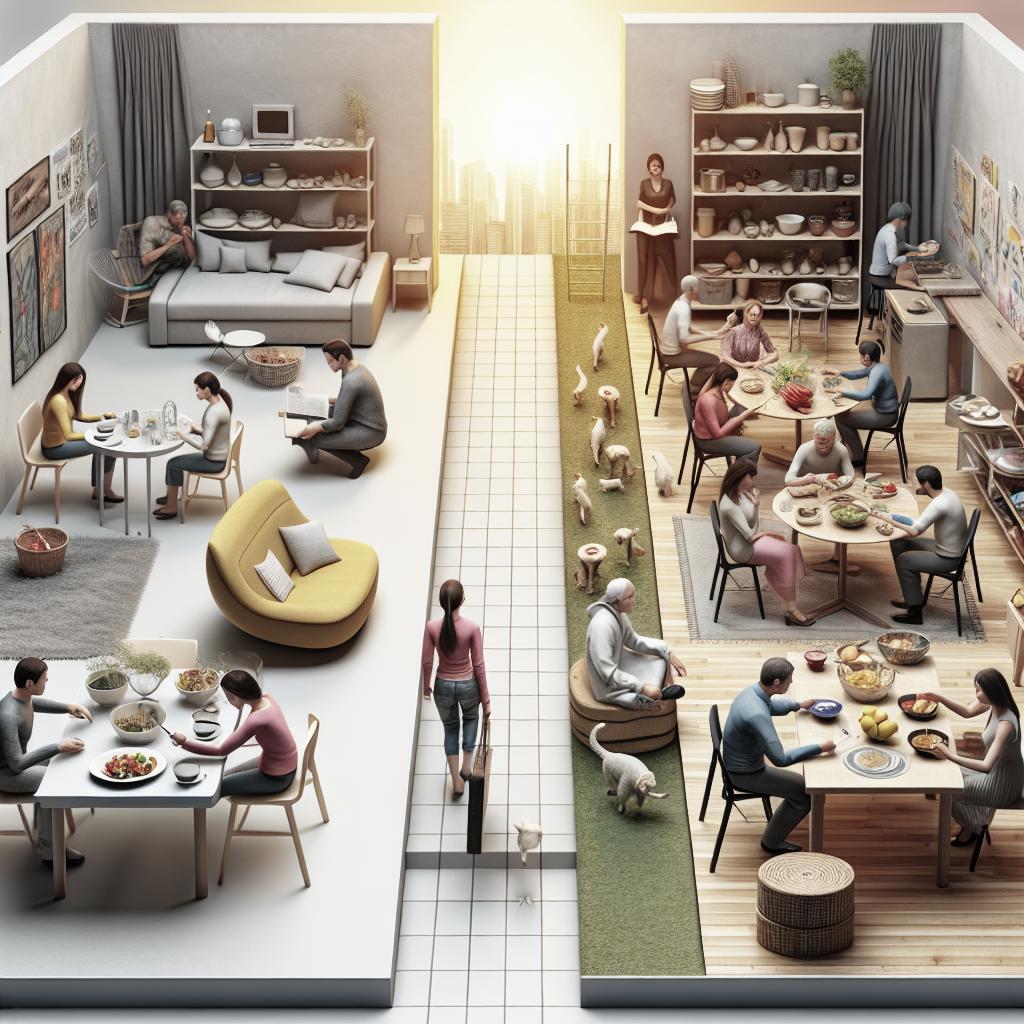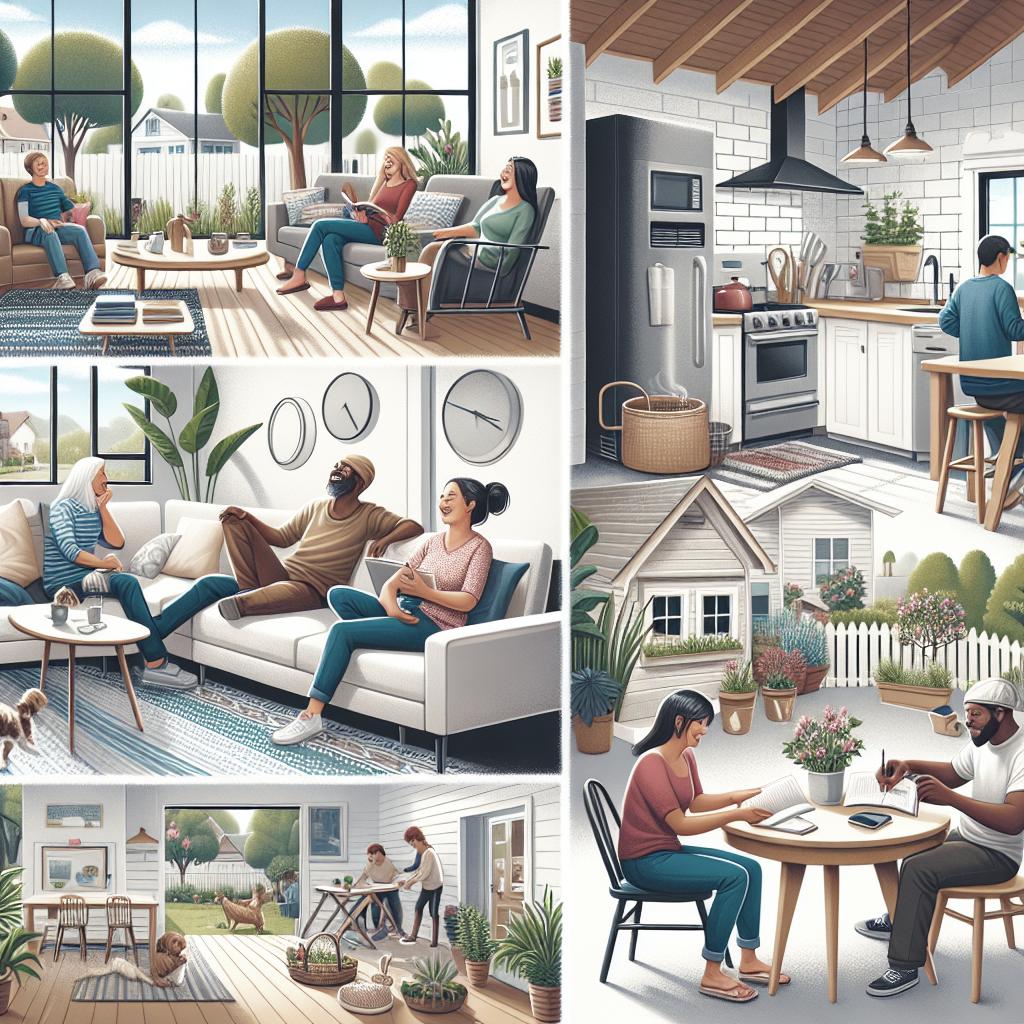The Transition from Individual to Communal Living
Transitioning from individual to communal living is a significant lifestyle change that comes with its unique benefits and challenges. This blog post explores various aspects of communal living, including my personal experiences, reasons for choosing this lifestyle, and insights on setting up and maintaining a thriving community. Through an understanding of how communes operate, you’ll gain a deeper appreciation of the communal lifestyle and whether it might be the right path for you. We’ll delve into the structure, costs, decision-making, and social dynamics of communal living.
I helped set up a commune in New York City in 2015, and have stayed in three others for periods of time in San Francisco. I’ve been so happy with the lifestyle that I’d like to live in a commune for the rest of my life. (This feels like a bold pronouncement to type. Yet plenty of people make life commitments, like marriage, at my age, so I might as well make a lifestyle commitment).
In 2015, I embarked on a transformative journey by helping to establish a commune in New York City. This experience opened my eyes to the unique dynamics and profound connections that only communal living can offer. Over time, I’ve also immersed myself in three different communes in San Francisco, each enriching my life in ways I hadn’t anticipated.
The happiness and fulfillment I’ve found in this lifestyle have inspired me to make a commitment to communal living for the rest of my life. While it may seem like a daring statement, especially coming from someone my age, life commitments aren’t solely limited to personal relationships like marriage. They can extend to lifestyle choices, too. For me, this lifestyle commitment offers a sense of belonging and purpose that traditional living arrangements often lack.
What are we really talking about?
Communal living, in essence, refers to a shared living arrangement where individuals come together to live cooperatively, often with shared resources and responsibilities. Unlike a simple cohabitation scenario, communes focus on values like sustainability, mutual aid, and collective decision-making.
This lifestyle can take many forms, from rural eco-villages and urban co-housing developments to more traditional intentional communities. The core concept is to create a space where individuals can live harmoniously, supporting one another in daily life while pursuing shared goals and values.
Why would you choose to live this way?
People choose communal living for various reasons, including the pursuit of a more sustainable lifestyle, the desire for stronger social connections, and the rejection of mainstream consumer culture. Communal living often provides a sense of belonging that traditional living approaches can’t match, fostering close-knit communities where members support one another both practically and emotionally.
Additionally, communal living can offer financial benefits due to shared resources and expenses, making it an attractive choice for those looking to reduce individual financial burdens while enhancing their quality of life. It’s a model that promotes collaboration and resourcefulness, ideal for those seeking a simpler, more connected existence.
Who lives in communes?
Communes attract a diverse group of people, from young professionals seeking community to older adults who wish to age in place with support from others. This lifestyle appeals to individuals committed to living sustainably, artists seeking collaborative spaces, and families desiring a communal upbringing for their children.
The common denominator among those who thrive in communal environments is a shared commitment to the community’s core values and the willingness to participate actively in communal activities. This diverse tapestry of members enriches the community, bringing varied perspectives and skills to the table.
How big are communes?
The size of communes can vary widely, from small groups of a few families to large communities of over a hundred people. The size often depends on the community’s goals, the space available, and the resources they can pool together. Smaller communes may offer closer relationships, while larger ones can provide more diverse interactions and resources.
It’s essential for each commune to establish its ideal size based on its vision, sustainability, and the capacity for effective community management. A balance between personal space and communal interaction is key to the community’s success and the well-being of its members.
How do you decide who joins?
The process of selecting new members is crucial for any commune, as it directly impacts the harmony and functionality of the community. Many communes have a formal application process, followed by interviews and trial periods to ensure prospective members align with communal values and dynamics.
Some communities may prioritize individuals with specific skills beneficial to the commune’s goals, while others might emphasize personality traits or a demonstrated commitment to communal living principles. The selection process is structured to foster inclusivity while maintaining the community’s integrity and mission.
How much does it cost to live in a commune?
The cost of living in a commune can fluctuate based on location, size, and the resources shared among members. Typically, expenses are lower than traditional living due to communal sharing of necessities like food, housing, and utilities.
Most communes require members to contribute financially through monthly dues or service exchange, balancing personal contributions with collective responsibilities. This framework encourages economical living while ensuring the community’s sustainability.
How much does it cost to start a commune?
Starting a commune involves initial costs, including land acquisition, construction, and legal fees. These expenses can be substantial and often necessitate pooling resources from founding members or securing loans and outside investments.
Despite these upfront costs, the collaborative nature of communal living can enable innovative financing methods and reduce individual financial burdens over time. Resource-sharing and sustainable practices can further offset ongoing costs, making communal living financially viable in the long term.
How do you control decision making?
Effective decision-making processes are vital for maintaining harmony and efficiency within a commune. Many communities adopt models like consensus decision-making, participatory democracy, or use sociocratic principles, ensuring that all members have a voice and that decisions reflect the group’s collective will.
Structured meetings, clear communication channels, and established conflict resolution mechanisms are foundational to smooth decision-making in communal settings. The focus is on collaborative leadership and fostering an inclusive environment where each member feels empowered.
How do you communicate day-to-day?
Day-to-day communication within a commune is facilitated through scheduled meetings, online platforms, and informal gatherings, promoting transparency and collaboration. Regular updates about communal projects, events, and changes ensure everyone remains informed and engaged.
Effective communication also involves active feedback loops where members can express concerns and ideas, fostering an open environment that values input from all community participants. This contributes to a vibrant culture of participation and continuous improvement.
How do you deal with significant others?
The dynamics of romantic relationships within communal settings can be complex, warranting clear boundaries and communication to harmonize personal relationships with communal responsibilities. Many communes establish guidelines to manage interpersonal relationships while respecting members’ privacy and autonomy.
Open discussions and support from the community can help navigate these dynamics, ensuring that personal relationships enhance rather than disrupt the communal equilibrium. Maintaining a respectful balance between individual needs and communal agreements is key.
How do you kick people out?
In unfortunate situations where a member’s behavior is detrimental to the community, communes have processes for addressing grievances and, if necessary, removing members. A transparent and fair process typically involves warnings, mediation, and, as a last resort, expulsion.
The goal is to protect the community’s well-being while exhaustively exploring solutions and giving individuals a chance to rectify their behavior. When removal is necessary, clear guidelines and respectful communication safeguard the community’s integrity.
Share this:
Share this article with others who might be intrigued by the concept of communal living. It’s an excellent way to spark conversations and explore how this lifestyle might fit into modern society. Encourage others to think about the possibilities and benefits communal living can offer.
Related
If you’re interested in communal living, here are some related topics you might find insightful:
- The Rise of Co-Housing: An Inside Look
- Sustainable Living: How Communes Are Leading the Way
- The Psychological Benefits of Living in a Community
Final Thoughts
| Aspect | Details |
|---|---|
| Personal Experience | Establishing a commune, personal growth, lifestyle commitment |
| Understanding Communes | Shared living arrangements, community values, diversity |
| Reasons for Communal Living | Social connections, financial benefits, sustainable lifestyle |
| Community Dynamics | Member diversity, commune size, joining process |
| Financial Aspects | Living costs, start-up expenses, resource sharing |
| Management | Decision-making, communication, conflict resolution |
| Relationships | Significant others, social dynamics, community agreements |


